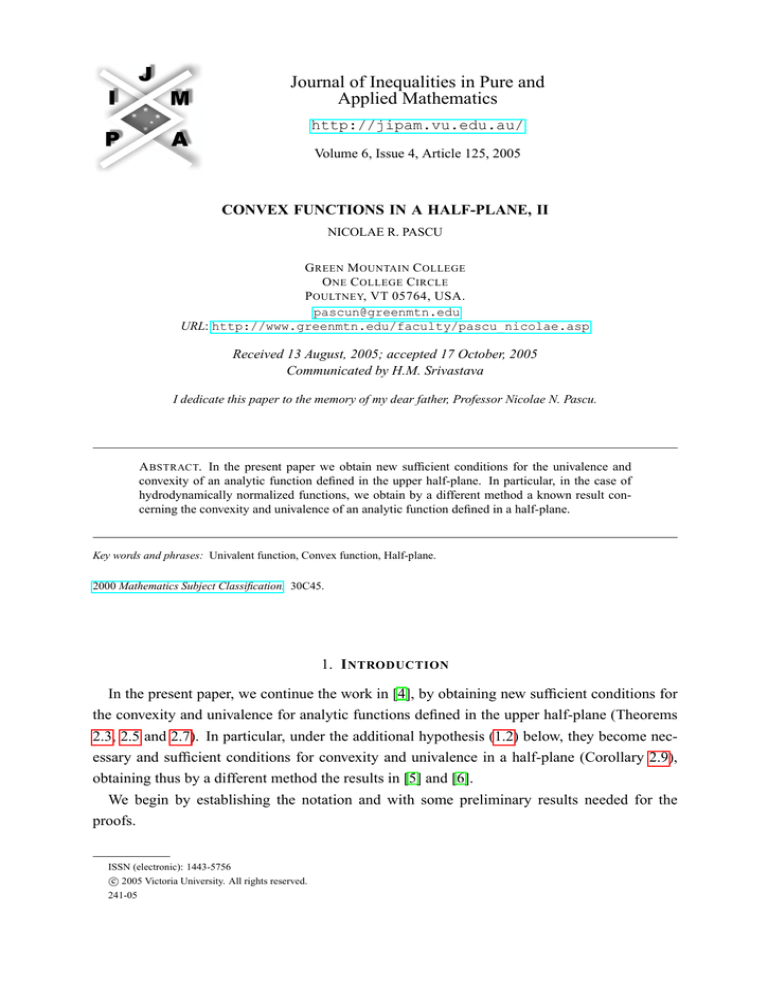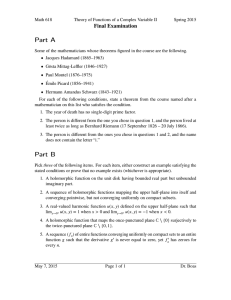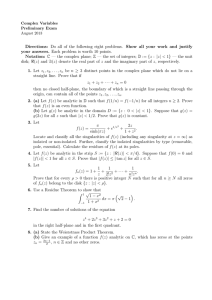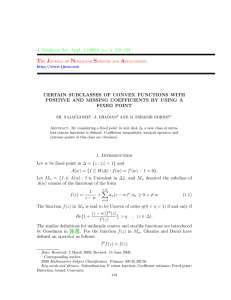
Journal of Inequalities in Pure and
Applied Mathematics
http://jipam.vu.edu.au/
Volume 6, Issue 4, Article 125, 2005
CONVEX FUNCTIONS IN A HALF-PLANE, II
NICOLAE R. PASCU
G REEN M OUNTAIN C OLLEGE
O NE C OLLEGE C IRCLE
P OULTNEY, VT 05764, USA.
pascun@greenmtn.edu
URL: http://www.greenmtn.edu/faculty/pascu_nicolae.asp
Received 13 August, 2005; accepted 17 October, 2005
Communicated by H.M. Srivastava
I dedicate this paper to the memory of my dear father, Professor Nicolae N. Pascu.
A BSTRACT. In the present paper we obtain new sufficient conditions for the univalence and
convexity of an analytic function defined in the upper half-plane. In particular, in the case of
hydrodynamically normalized functions, we obtain by a different method a known result concerning the convexity and univalence of an analytic function defined in a half-plane.
Key words and phrases: Univalent function, Convex function, Half-plane.
2000 Mathematics Subject Classification. 30C45.
1. I NTRODUCTION
In the present paper, we continue the work in [4], by obtaining new sufficient conditions for
the convexity and univalence for analytic functions defined in the upper half-plane (Theorems
2.3, 2.5 and 2.7). In particular, under the additional hypothesis (1.2) below, they become necessary and sufficient conditions for convexity and univalence in a half-plane (Corollary 2.9),
obtaining thus by a different method the results in [5] and [6].
We begin by establishing the notation and with some preliminary results needed for the
proofs.
ISSN (electronic): 1443-5756
c 2005 Victoria University. All rights reserved.
241-05
2
N ICOLAE R. PASCU
We denote by D = {z ∈ C : Im z > 0} the upper half-plane in C and for ε ∈ 0, π2 we let
Tε be the angular domain defined by:
n
o
π
π
(1.1)
Tε = z ∈ C∗ : − ε < arg (z) < + ε .
2
2
We say that a function f : D → C is convex if f is univalent in D and f (D) is a convex
domain.
For an arbitrarily chosen positive real number y0 > 0 we denote by Ay0 the class of functions
f : D → C analytic in the upper half-plane D satisfying f (iy0 ) = 0 and such that f 0 (z) 6= 0
for any z ∈ D. In particular, for y0 = 1 we will denote A1 = A.
We will refer to the following normalization condition for analytic functions f : D → C as
the hydrodynamic normalization:
(1.2)
lim
z→∞,z∈D
(f (z) − z) = ai,
where a ≥ 0 is a non-negative real number, and we will denote by H1 the class of analytic
functions f : D → C satisfying this condition in the particular case a = 0.
For analytic functions satisfying the above normalization condition, J. Stankiewicz and Z.
Stankiewicz obtained (see [5] and [6]) the following necessary and sufficient condition for convexity and univalence in a half-plane:
Theorem 1.1. If the function f ∈ H1 satisfies:
(1.3)
f 0 (z) 6= 0,
for all z ∈ D
and
(1.4)
Im
f 00 (z)
> 0,
f 0 (z)
for all z ∈ D,
then f is a convex function.
In order to prove our main result we need the following results from [2]:
Lemma 1.2. If the function f : D → D is analytic in D, then for any ε ∈ 0, π2 the following
limits exist and we have the equalities:
lim
z→∞,z∈Tε
f (z)
= lim f 0 (z) = c,
z→∞,z∈Tε
z
where c ≥ 0 is a non-negative real number.
Moreover, for any z ∈ D we have the inequality
Im f (z) ≥ c Im z,
(1.5)
and if there exists z0 ∈ D such that we have equality in the inequality (1.5), then there exists a
real number a such that
f (z) = cz + a,
J. Inequal. Pure and Appl. Math., 6(4) Art. 125, 2005
for all z ∈ D.
http://jipam.vu.edu.au/
C ONVEX F UNCTIONS IN A H ALF - PLANE , II
3
D
cr
Drs
a
ds
b
Figure 2.1: The domain Drs .
Lemma 1.3. If the function f : D → D is analytic in D and hydrodynamically normalized,
then for any ε ∈ (0, π2 ) and any natural number n ≥ 2 we have
lim
z n f (n) (z) = 0.
z→∞,z∈Tε
2. M AIN R ESULTS
Let us consider the family of domains Dr,s in the complex plane, defined by
Dr,s = {z ∈ C : |z| < r, Im z > s} ,
where r and s are positive real numbers, 0 < s < r (see Figure 2.1).
Let us note that for any r > 1 and 0 < s < 1 we have the inclusion Dr,s ⊂ D, and that for
any z ∈ D arbitrarily fixed, there exists rz > 0 and sz > 0 such that z ∈ Dr,s for any r > rz
and any 0 < s < sz (for example, we can choose rz and sz such that they satisfy the conditions
rz > |z| and sz ∈ (0, Im z)).
We denote by Γr,s = cr ∪ ds the boundary of the domain Dr,s , where cr and ds are the arc of
the circle, respectively the line segment, defined by:
(
cr = {z ∈ C : |z| = r, z ≥ s}
.
ds = {z ∈ C : |z| ≤ r, z = s}
The curve Γr,s has an exterior normal vector at any point, except for the points a and b (with
arg a < arg b) where the line segment ds and the arc of the circle cr meet (see Figure 2.1). The
exterior normal vector to the curve f (cr ) at the point f (z), with z = reit ∈ cr , t ∈ (arg a, arg b),
J. Inequal. Pure and Appl. Math., 6(4) Art. 125, 2005
http://jipam.vu.edu.au/
4
N ICOLAE R. PASCU
has the argument
(2.1)
ϕ (t) = arg (zf 0 (z)) ,
and the exterior normal vector to the curve f (ds ) at the point f (z), with z = x + is ∈ ds ,
x ∈ (Re b, Re a), has the argument
π
(2.2)
ψ (x) = − + arg f 0 (x + is) .
2
Definition 2.1. We say that the function f ∈ A is convex on the curve Γr,s if the argument of
the exterior normal vector to the curve f (Γr,s ) − {f (a), f (b)} is an increasing function.
Remark 2.1. In particular, the condition in the above theorem is satisfied if the functions ϕ and
ψ defined by (2.1)–(2.2) are increasing functions.
Let us note that for z = reit ∈ cr , we have:
it 00
∂
re f (reit )
∂ it 0
it 0
it
it log re f re
=i
+
1
=
ln
re
f
re
+ iϕ0 (t) ,
∂t
f 0 (reit )
∂t
and for z ∈ ds :
∂
f 00 (x + is)
∂
log f 0 (x + is) = 0
=
ln |f 0 (x + is)| + iψ 0 (x + is) .
∂x
f (x + is)
∂x
We obtain therefore
reit f 00 (reit )
ϕ0 (t) =
+ 1,
f 0 (reit )
for reit ∈ cr , and
f 00 (x + is)
,
ψ 0 (x + is) = 0
f (x + is)
for x + is ∈ ds , and from the previous observation it follows that if the function f ∈ A satisfies
the inequalities
zf 00 (z)
f 0 (z) + 1 > 0, z ∈ cr
(2.3)
,
f 00 (z)
> 0,
z ∈ ds
f 0 (z)
the function f is convex on the curve Γr,s , and therefore f (Dr,s ) is a convex domain.
Since the function f has in the domain Dr,s bounded by the curve Γr,s a simple zero, from
the argument principle it follows that the total variation of the argument of the function f on the
curve Γr,s is 2π, and therefore f is injective on the curve Γr,s . From the principle of univalence
on the boundary, it follows that the function f is univalent Dr,s .
We obtained the following:
Theorem 2.2. If the function f belongs to the class A and there exist real numbers 0 < s <
1 < r such that conditions (2.3) are satisfied, then the function f is univalent in the domain
Dr,s and f (Dr,s ) is a convex domain.
More generally, we have the following:
J. Inequal. Pure and Appl. Math., 6(4) Art. 125, 2005
http://jipam.vu.edu.au/
C ONVEX F UNCTIONS IN A H ALF - PLANE , II
5
Theorem 2.3. If the function f : D → C belongs to the class A and there exist real numbers
0 < s0 < 1 < r0 such that:
(2.4)
Re
zf 00 (z)
+1>0
f 0 (z)
for any z ∈ D with |z| > r0 , and
f 00 (z)
>0
f 0 (z)
for any z ∈ D with Im z < s0 , then the function f is convex and univalent in the half-plane D.
(2.5)
Im
Proof. Let z1 and z2 be arbitrarily fixed distinct points in the half-plane D. For any r > r∗ =
max {|z1 | , |z2 |} and any s ∈ (0, s∗ ), where s∗ = min {Im z1 , Im z2 }, the points z1 and z2
belong to the domain Dr,s .
From the hypothesis (2.4) and (2.5) and using the Remark 2.1 it follows that for any r > r0
and s ∈ (0, s0 ) the function f is univalent in the domain Dr,s , and that f (Dr,s ) is a convex
domain.
Therefore, choosing r > max {r0 , r∗ } and s ∈ (0, s1 ), where s1 = min {s0 , s∗ }, it follows
that the points z1 and z2 belong to the domain Dr,s , and since the function f is univalent in the
domain Dr,s , we obtain that f (z1 ) 6= f (z2 ).
Since z1 and z2 were arbitrarily chosen in the half-plane D, it follows that the function f is
univalent in D, concluding the first part of the proof.
In order to show that f (D) is a convex domain, we consider w1 and w2 arbitrarily fixed
distinct points in f (D), and let z1 = f −1 (w1 ) and z2 = f −1 (w2 ) be their preimages.
Repeating the above proof it follows that the points z1 and z2 belong to the domain Dr,s (for
any r > max {r0 , r∗ } and s ∈ (0, s1 ), where s1 = min {s0 , s∗ }, in the notation above), and
therefore we obtain that w1 = f (z1 ) ∈ f (Dr,s ) and w2 = f (z2 ) ∈ f (Dr,s ).
Since f (Dr,s ) is a convex domain, it follows that the line segment [w1 , w2 ] is also contained
in the domain f (Dr,s ), and since f (Dr,s ) ⊂ f (D), we obtain that [w1 , w2 ] ⊂ f (D).
Since w1 , w2 ∈ f (D) were arbitrarily chosen, it follows that f (D) is a convex domain,
concluding the proof.
Remark 2.4. The point z0 = i, in which the functions f belonging to the class A = A1 are
normalized can be replaced by any point z0 = iy0 , with y0 > 0. Repeating the proof of the
previous theorem with this new choice for the normalization condition, we obtain the following
result which generalizes the previous theorem:
Theorem 2.5. If the function f : D → C belongs to the class Ay0 for some y0 > 0, and there
exist real numbers 0 < s0 < y0 < r0 such that
zf 00 (z)
f 0 (z) + 1 > 0, z ∈ D, |z| > r0
,
f 00 (z)
> 0,
z ∈ D, z ∈ (0, s0 )
f 0 (z)
J. Inequal. Pure and Appl. Math., 6(4) Art. 125, 2005
http://jipam.vu.edu.au/
6
N ICOLAE R. PASCU
then the function f is univalent and convex in the half-plane D.
Remark 2.6. By noticing that the function f : D → C is convex and univalent in D if and
only the function f˜ : D → C, fe(z) = f (z) − f (iy0 ) is convex and univalent in D, for any
arbitrarily chosen point y0 > 0, and replacing the function f in the previous theorem by fe(z) =
f (z) − f (iy0 ), we can eliminate from the hypothesis of this theorem the condition f (iy0 ) = 0,
obtaining the following more general result:
Theorem 2.7. If the function f : D → C is analytic in D, satisfies f 0 (z) 6= 0 for all z ∈ D and
there exist real numbers 0 < s0 < r0 such that the following inequalities hold:
zf 00 (z)
f 0 (z) + 1 > 0, z ∈ D, |z| > r0
(2.6)
,
f 00 (z)
> 0,
z ∈ D, z ∈ (0, s0 )
f 0 (z)
then the function f is convex and univalent in the half-plane D.
Example 2.1. For a ∈ R, consider the function fa : D → C defined by
fa (z) = z a ,
z ∈ D,
where we have chosen the determination of the power function corresponding to the principal
branch of the logarithm, that is:
z a = ea log z ,
z ∈ D,
where log z denotes the principal branch of the logarithm (with log i = i π2 ).
We have
fa0 (i) = aia−1
(a − 1) π
(a − 1) π
+ i sin
= a cos
2
2
6= 0,
for any a 6= 0.
For an arbitrarily chosen z ∈ D we have:
fa00 (z)
1
= (a − 1)
0
fa (z)
z
(a − 1) z
=−
|z|2
>0
for any a < 1, and also
zfa00 (z)
+ 1 = (a − 1) + 1
fa0 (z)
= a
>0
J. Inequal. Pure and Appl. Math., 6(4) Art. 125, 2005
http://jipam.vu.edu.au/
C ONVEX F UNCTIONS IN A H ALF - PLANE , II
7
for any a > 0.
It follows that the hypotheses of the previous theorem are satisfied for any a ∈ (0, 1), and
according to this theorem it follows that the function fa (z) = z a (z ∈ D) is convex and univalent
in the half-plane D for any a ∈ (0, 1).
It is easy to see that the function fa (z) = z a , z ∈ D, is convex and univalent for any
a ∈ (−1, 0) ∪ (0, 1), and therefore the previous theorem gives only sufficient conditions for the
convexity and univalence of an analytic function defined in the upper half-plane D.
Remark 2.8. As shown in [4], the condition
f 00 (z)
> 0, z ∈ D,
f 0 (z)
is a necessary condition (but not also a sufficient one) for an analytic function in D to be convex
and univalent in D.
However, in the case of a hydrodynamically normalized function, as shown in Theorem 1.1
(see [5] and [6]), this becomes also a sufficient condition for the convexity and the univalence
in the half-plane D. We recall that the hydrodynamic normalization used by Stankiewicz in is
given by
lim
(2.7)
z→∞,z∈D
(f (z) − z) = 0.
In particular, in the case of analytic and hydrodynamically normalized functions in the upper
half-plane, from Theorem 2.7 we can obtain as a consequence a new proof of the last cited
result, namely a necessary and sufficient condition for the convexity and the univalence of an
analytic, hydrodynamically normalized function defined in the half-plane, as follows:
Corollary 2.9. If the function f : D → C is analytic and hydrodynamically normalized by (1.2)
in the half-plane D, and it satisfies
f 0 (z) 6= 0 for all z ∈ D
(2.8)
and
f 00 (z)
> 0, for all z ∈ D,
f 0 (z)
then the function f is convex and univalent in the half-plane D.
(2.9)
Im
Proof. Since f satisfies the hydrodynamic normalization condition
lim
z→∞,z∈D
(f (z) − z − ai) = 0,
for some a ≥ 0, it follows that for any ε0 > 0 there exists r > 0 such that for z ∈ D with |z| > r
we have:
|Im (f (z) − z − ai)| ≤ |f (z) − z − ai| < ε0 ,
and therefore we obtain
Im f (z) > Im z + a − ε0 ,
J. Inequal. Pure and Appl. Math., 6(4) Art. 125, 2005
http://jipam.vu.edu.au/
8
N ICOLAE R. PASCU
for any z ∈ D with |z| > r.
Choosing y0 = max {r, ε − a} and considering the auxiliary function g : D → C defined
by
g (z) = f (z + 2iy0 )
it follows that for all z ∈ D we have:
g (z) = f (z + 2iy0 )
> z + 2y0 + a − ε
> y0
> 0,
which shows that g : D → D.
Since the function f is hydrodynamically normalized, the function g is also hydrodynamically normalized, and from Lemma 1.2 we obtain
lim
z→∞,z∈Tε
f 0 (z + 2iy0 ) =
=
lim
g 0 (z)
lim
g (z)
z
z→∞,z∈Tε
z→∞,z∈Tε
= 1,
since from the hydrodynamic normalization condition we have
g (z) − z
g (z)
− 1 = lim
z→∞,z∈D
z→∞,z∈D
z
z
lim g(z) − z
z→∞,z∈D
=
limz→∞,z∈D z
ai
=
lim z
lim
z→∞,z∈D
= 0,
and therefore we obtain
lim
z→∞,z∈Tε
g(z)
z
= 1, for any ε ∈ (0, π2 ).
From Lemma 1.3, applied to the function g in the particular case n = 2, we obtain:
2 00 lim
z g (z) = 0,
z→∞,z∈Tε
for any ε ∈ (0, π2 ), and therefore we obtain
2 00 lim
z f (z) = lim
(z − 2iy0 )2 g 00 (z − 2iy0 )
z→∞,z∈Tε
Since
lim
z→∞,z∈D
z→∞,z∈Tε
f 0 (z) = 1, we obtain
lim
z→∞,z∈Tε
for any ε ∈ (0,
z2
= 0.
(z − 2iy0 )2
zf 00 (z)
= 0,
f 0 (z)
π
).
2
J. Inequal. Pure and Appl. Math., 6(4) Art. 125, 2005
http://jipam.vu.edu.au/
C ONVEX F UNCTIONS IN A H ALF - PLANE , II
9
It follows that for any ε ∈ (0, π2 ) arbitrarily fixed, there exists r0 > 0 such that
zf 00 (z)
+ 1 > 0,
f 0 (z)
for any z ∈ Tε with |z| > r0 .
Following the proof Theorem 2.7 it can be seen that this inequality together with the hypotheses (2.8) and (2.9) suffices for the proof, and therefore the function f is convex and univalent in
the half-plane D, concluding the proof.
R EFERENCES
[1] F.G. AVHADIEV, Some univalent mappings of the half-plane (Russian), Trudy Sem. Kraev. Zadačam
Vyp., 11 (1974), 3–8.
[2] N.R. PASCU, Some properties of Caratheodory functions in the half-plane (to appear).
[3] N.N. PASCU, On univalent functions in a half-plane, Studia Univ. “Babeş-Bolyai”, Math., 46(2)
(2001), 93–96.
[4] N.N. PASCU AND N.R. PASCU, Convex functions functions in a half-plane, J. Inequal. Pure Appl.
Math., 4(5) (2003), Art. 102. [ONLINE http://jipam.vu.edu.au/article.php?sid=
343].
[5] J. STANKIEWICZ AND Z. STANKIEWICZ, On the classes of functions regular in a half-plane I,
Bull. Polish Acad. Sci. Math., 39(1-2) (1991), 49–56.
[6] J. STANKIEWICZ, Geometric properties of functions regular in a half-plane, Current Topics in
Analytic Function Theory, World Sci. Publishing, River Edge NJ, pp. 349–362 (1992).
J. Inequal. Pure and Appl. Math., 6(4) Art. 125, 2005
http://jipam.vu.edu.au/








